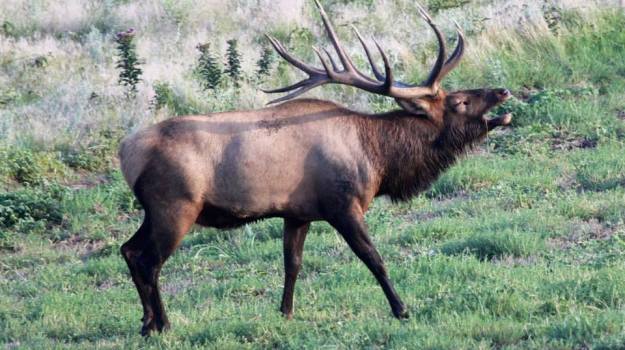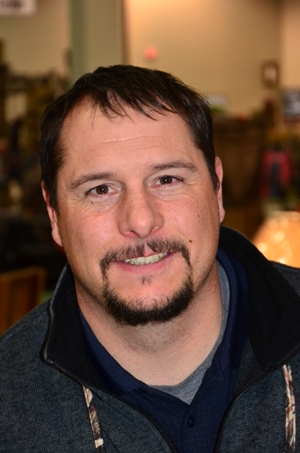
On one opening-day archery hunt, we got up before daylight and went to the spot where we could watch wide expanses and a deep canyon. My hunter saw several big bulls, and I talked him into going down in the canyon, an 1800-foot descent to reach the bottom. I knew there was good water down there and several wallows. We went to the end of the canyon that had only two ways out - climb straight up the mountain, which was a tough hike, or walk a trail for about 5 miles. Before we reached the bottom of the canyon, we heard five or six different bulls bugling. I knew that after the bulls came down to the water, they usually made that climb over the top of the mountain to go down into thick timber to bed at the end of the day.
 As we were walking down the trail, I would cow call. I kept hearing a bull on top of the mountain, staying up with us and walking parallel to us. “We’ve got one chance to take that bull up on the mountain,” I told my hunter. “We need to continue to walk down the trail we’re on and see if we can get to the saddle in the mountain before the bull arrives. Then we’ll have an opportunity to take him.” We arrived at the saddle ahead of the bull. I cow called to him, and the bull bugled and came straight for us. When I looked back at my hunter, I saw that he had an older Mathews’ bow and an aluminum arrow. Although I had my doubts that my bowhunter could make the shot and take the bull elk with that antiquated equipment, I didn’t say anything.
As we were walking down the trail, I would cow call. I kept hearing a bull on top of the mountain, staying up with us and walking parallel to us. “We’ve got one chance to take that bull up on the mountain,” I told my hunter. “We need to continue to walk down the trail we’re on and see if we can get to the saddle in the mountain before the bull arrives. Then we’ll have an opportunity to take him.” We arrived at the saddle ahead of the bull. I cow called to him, and the bull bugled and came straight for us. When I looked back at my hunter, I saw that he had an older Mathews’ bow and an aluminum arrow. Although I had my doubts that my bowhunter could make the shot and take the bull elk with that antiquated equipment, I didn’t say anything.
Once the bull got to 40 yards and stopped across the trail, I cow called. My hunter was at full draw, and the shot came so fast, I didn’t see the arrow fly by but heard it, “Whop,” when the broadhead hit the bull. The bull took off running, and then the mountain went silent. Since I didn’t hear the bull stumble or fall, in my mind, I thought that hunter probably had gotten a flesh wound on the elk. I asked my bowhunter, “Where did your arrow hit the elk?” We walked up to the spot where the elk was when he’d shot him and discovered a couple of spots of blood. We walked up the trail and crossed over the mountain to go down into a deep ravine. We hadn’t gone but 30 yards when we found the bull piled up. When we dressed the elk, I saw that the broadhead at the front of that aluminum shaft had gone straight into the elk’s heart. To get the bull out, we went back to camp, got horses and trailered them to the trailhead. We rode up the mountain, quartered the elk, put the meat in the duffels on the horses and let the horses pack the animal to the camp.
Day 3: Colorado’s Mike Miller Tells Us about an Opening Morning Elk Archery Hunt



























